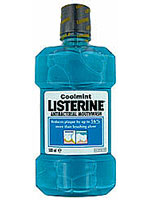 Ingredients
Ingredients-
- Aqua
- Alcohol
- Sodium saccharin
- Sorbitol
- Eucalyptol
- Thymol
- Menthol
- Poloxamer 407
- Methyl salicylate
- Sodium fluoride
- Benzoic acid
- Sodium benzoate
- C1 42053
- C1 47005
Published August 2009
Listerine kills the microbes that cause bad breath and plaque, and it strengthens teeth. Bad breath is due to the action of bacteria feeding on sulfur-containing proteins. Plaque consists of colonies of microorganisms.
Ingredients
Aqua (aka deionised water) and alcohol (aka ethanol) are the solvents which dissolve the various ingredients. The presence of alcohol makes this mouthwash unacceptable to Muslims.
Sodium saccharin (aka 1,2-benzisothiazol-3-one 1,1-dioxide) is an artificial sweetener made from 2-aminobenzoic acid, nitrous acid, sulfur dioxide and chlorine. Previous fears that it might cause bladder cancer proved to be unfounded.
Sorbitol (hexane-1,2,3,4,5,6-hexol) is a natural sweetener and present in apples, but is manufactured industrially from glucose. It does not cause tooth decay.
Eucalyptol is obtained by distilling eucalyptus oil. It has a pleasant aroma and is used in many products for this reason. It is also known to attract orchid bees and is used as a bait for this purpose.
Thymol (aka 5-methyl-2-isopropyl -1-phenol) is a natural oil with strong antiseptic properties. It was formerly used for preserving art objects and urine samples.
Menthol (aka 5-metyhyl-2-(1-methylethyl)cyclohexanol) occurs naturally in peppermint oil and is an ingredient in throat lozenges and cooling salves. It triggers the cold-sensitive receptors in the mouth, producing a fresh feel and is added to cigarettes such as Consulate to reduce the irritant effect of the smoke.
Poloxamer 407 (aka methyl oxirane polymer) is used to solubilise the oily ingredients eucalyptol, thymol and menthol. Poloxamers are non-ionic surfactants which allow oil and water to mix. They are used as defoaming agents, wetting agents, emulsifiers, and they are safe to use in foods. Poloxamer 407 is also found in contact lens cleaning solutions and is used as a binder in pills.
Methyl salicylate (aka oil of wintergreen, methyl-2-hydroxybezoate) is what give embrocation its characteristic odour. This rubbing oil was used to treat aches and pains and especially for sport injuries but it can irritate the skin and will sting when used on sensitive areas.
Sodium fluoride (chemical formula NaF) strengthens tooth enamel by converting the apatite (calcium phosphate) of this outer layer to a stronger form called fluoroapatite. Sodium fluoride is a white powder which has been used as a cockroach and ant poison and for disinfecting fermentation vessels in breweries. In parts of India, where fluoride levels are high, it had led to bone deformities in the population. However, the level in fluoridated drinking water, and in Listerine, does not pose a threat.
Benzoic acid and sodium benzoate are there to kill any bacteria that might find their way into the Listerine. Although some groups oppose these preservatives, mistakenly believing them to cause hyperactivity in children, they are present naturally in fruits like cranberries and strawberries.
CI 42053 is a green dye and CI 47005 is a yellow dye.